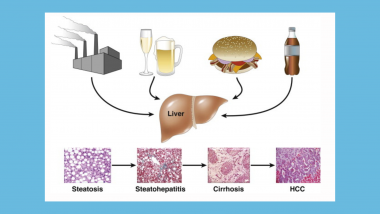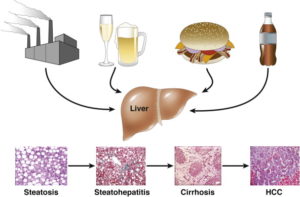Through the end of the year, we’re bringing back some of the best articles from the AGA Journals blog, Digest This. Learn more about the causes of fatty liver disease in this article originally published in August 2015.
Hepatic steatosis and steatohepatitis are increasing in prevalence, and can progress to histologically identical, more severe liver disease. They are associated with 3 main factors: alcohol, obesity or metabolic syndrome, and exposure to toxins. Researchers review the similarities, differences and pathogenic mechanisms of alcohol-associated steatohepatitis (ASH), nonalcoholic steatohepatitis (NASH) and toxicant-associated fatty liver disease (TASH) in the July issue of Cellular and Molecular Gastroenterology and Hepatology.
In the review, Swati Joshi-Barve et al explain that alcohol-derived and environmental toxin vinyl chloride are each metabolized via cytochrome P450 2E1 (CYP2E1) to form toxic aldehyde intermediates. Fructose is also metabolized to an aldehyde. So, these 3 divergent forms of steatohepatitis all appear to have aldehyde as an intermediate.
On the other hand, dietary unsaturated fat appears to protect against NASH, but n-6 unsaturated fat appears to promote development of ASH.
Different types of steatohepatitis can interact. For example, high-fat feeding and subsequent NASH reduces levels of glutathione S-transferases, which protect against some toxins in the environment and are derived from alcohol.
The authors discuss how nutrition, the intestinal barrier and microbiota, immune response, oxidative stress, ER stress and the extracellular matrix all affect development of fatty liver disease. They also summarize the genetic and epigenetic factors important for disease development and progression.
Joshi-Barve et al say that better biomarkers of ASH, NASH and TASH, as well as model systems that more closely resemble human disease, are needed to understand how these types of steatosis develop and to develop new therapies.

Kristine Novak, MD
Dr. Novak is a science writer and editor based in San Francisco. She has extensive experience covering gastroenterology, hepatology, immunology, oncology, clinical and biotechnology research discoveries.














